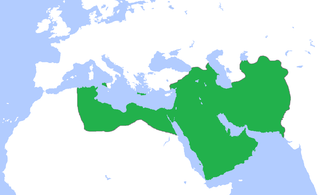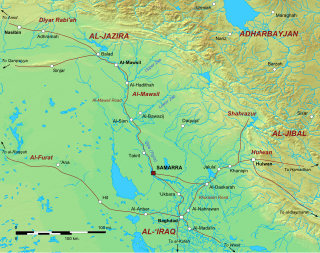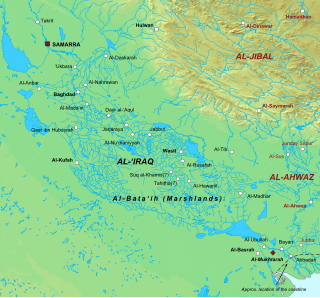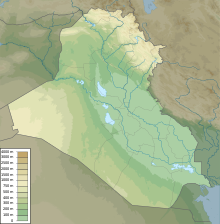
Abū ʿAbd Allāh Muḥammad ibn Jaʿfar ibn Muḥammad ibn Hārūn al-Muʿtazz bi-ʾLlāh, better known by his regnal title al-Muʿtazz bi-ʾLlāh was the Abbasid caliph from 866 to 869, during a period of extreme internal instability within the Abbasid Caliphate, known as the "Anarchy at Samarra".

Abu’l-ʿAbbās Aḥmad ibn Jaʿfar ibn Muḥammad ibn Hārūn al-Muʿtamid ʿalā’Llāh, better known by his regnal name al-Muʿtamid ʿalā ’llāh, was the caliph of the Abbasid Caliphate from 870 to 892. His reign marks the end of the "Anarchy at Samarra" and the start of the Abbasid restoration, but he was largely a ruler in name only. Power was held by his brother al-Muwaffaq, who held the loyalty of the military. Al-Mu'tamid's authority was circumscribed further after a failed attempt to flee to the domains controlled by Ahmad ibn Tulun in late 882, and he was placed under house arrest by his brother. In 891, when al-Muwaffaq died, loyalists attempted to restore power to the Caliph, but were quickly overcome by al-Muwaffaq's son al-Mu'tadid, who assumed his father's powers. When al-Mu'tamid died in 892, al-Mu'tadid succeeded him as caliph.

Abū al-ʿAbbās Aḥmad ibn Ṭalḥa ibn Jaʿfar ibn Muḥammad ibn Hārūn Al-Muʿtaḍid bi'Llāh, 853/4 or 860/1 – 5 April 902, better known by his regnal name al-Muʿtaḍid bi-llāh, was the caliph of the Abbasid Caliphate from 892 until his death in 902.

Ya'qūb ibn al-Layth al-Saffār, was a coppersmith and the founder of the Saffarid dynasty of Sistan, with its capital at Zaranj. Under his military leadership, he conquered much of the eastern portions of Greater Iran consisting of modern-day Iran, Afghanistan, Turkmenistan, Uzbekistan, Tajikistan as well as portions of western Pakistan and a small part of Iraq. He was succeeded by his brother, Amr ibn al-Layth.

The Zanj Rebellion was a major revolt against the Abbasid Caliphate, which took place from 869 until 883. Begun near the city of Basra in present-day southern Iraq and led by one Ali ibn Muhammad, the insurrection involved both enslaved and freed East Africans or Abyssinians exported in the Indian Ocean slave trade and transported to slavery in the Abbasid Caliphate in the Middle East, principally to drain the region's salt marshes. It grew to involve slaves and freemen, including both Eastern Africans and Arabs, from several regions of the Caliphate, and claimed tens of thousands of lives before it was fully defeated.
Abu'l-Sāj Dēvdād was a Sogdian prince, who was of the most prominent emirs, commanders and officials of the Abbasid Caliphate. He was the eponymous ancestor of the Sajid dynasty of Azerbaijan. His father was named Devdasht.
Abu 'Abdallah Muhammad ibn Tahir ibn 'Abdallah was the last Tahirid governor of Khurasan, from 862 until 873. He was the governor during the period of Extreme instability in Abbasid Caliphate and Civil war of 865–866. His career spanned under four caliphs al-Musta'in, al-Mu'tazz, al-Muhtadi and al-Mu'tamid. He was later appointed as governor of Baghdad by caliph al-Mu'tamid from 885 to 889.
Abu Ahmad Ṭalḥa ibn Jaʿfar ibn Muḥammad ibn Hārūn al-Muwaffaq bi'Llah, better known by his laqab as Al-Muwaffaq Billah, was an Abbasid prince and military leader, who acted as the de facto regent of the Abbasid Caliphate for most of the reign of his brother, Caliph al-Mu'tamid. His stabilization of the internal political scene after the decade-long "Anarchy at Samarra", his successful defence of Iraq against the Saffarids and the suppression of the Zanj Rebellion restored a measure of the Caliphate's former power and began a period of recovery, which culminated in the reign of al-Muwaffaq's own son, the Caliph al-Mu'tadid.
Muhammad bin Wasil ibn Ibrahim al-Tamimi was a military adventurer who seized control of the Abbasid province of Fars in 870. He intermittently ruled over Fars until 876, when he was captured and imprisoned by Ya'qub ibn al-Layth, the Saffarid emir of Sistan.

The Anarchy at Samarra was a period of extreme internal instability from 861 to 870 in the history of the Abbasid Caliphate, marked by the violent succession of four caliphs, who became puppets in the hands of powerful rival military groups.
The Maghariba were a regiment in the regular army of the Abbasid Caliphate. The unit was formed in the early ninth century A.D. and consisted of soldiers who were of North African origin. During their history, the Maghariba participated in several military campaigns and played a significant role in the politics of the central government.
The Faraghina were a regiment in the regular army of the Abbasid Caliphate which was active during the ninth century A.D. Consisting of troops who originated from the region of Farghana in Transoxiana, the Faraghina participated in several military campaigns and played a significant role in the politics of the central government, especially during the Anarchy at Samarra.

The Kharijite Rebellion was a major Kharijite uprising against the Abbasid Caliphate between 866 and 896. Centered in the districts of Mosul and Diyar Rabi'a in the province of al-Jazira, the rebellion lasted for approximately thirty years, despite numerous attempts by both the central government and provincial authorities to quell it. It was finally defeated in 896 after the caliph al-Mu'tadid undertook several campaigns to restore caliphal authority in the region.

Ja'far ibn Ahmad al-Mu'tamid, better known by his laqab al-Mufawwid ila-llah, was a son of the Abbasid caliph al-Mu'tamid and heir-apparent of the Caliphate from 875 until his sidelining by his cousin al-Mu'tadid in 891.
Ishaq ibn Kundaj or Kundajiq, was a Turkic military leader who played a prominent role in the turbulent politics of the Abbasid Caliphate in the late 9th century. Initially active in lower Iraq in the early 870s, he came to be appointed governor of Mosul in the Jazira in 879/80. He ruled Mosul and much of the Jazira almost continuously until his death in 891, despite becoming involved in constant quarrels with local chieftains, as well as in the Abbasid government's rivalry with the Tulunids of Egypt. On his death he was succeeded by his son, Muhammad, but in 892 the Abbasid government under Caliph al-Mu'tadid re-asserted its authority in the region, and Muhammad went to serve in the caliphal court.
Masrur al-Balkhi was a senior military officer in the late-9th century Abbasid Caliphate.
Muflih al-Turki was a Turkish military officer of the Abbasid Caliphate in the mid-9th century. He played a prominent role in the events known as the Anarchy at Samarra and was later killed in battle against the Zanj rebels of southern Iraq.

The al-Ahwaz theater was one of two major areas of operations during the Zanj Rebellion, the other being the regions of lower and central Iraq. Beginning in 869, Zanj armies repeatedly entered the province of al-Ahwaz and succeeded in scoring several victories against the defending forces of the Abbasid Caliphate. Over the course of the next decade, the rebels attacked and looted many of the cities in the region, including Suq al-Ahwaz, 'Askar Mukram and Ramhurmuz. By the height of the rebellion in the mid-870s the Zanj were effectively in control of extensive portions of the province, appointing governors to the districts under their sway and collecting supplies from the local population. During this period, the Zanj in al-Ahwaz were usually commanded by 'Ali ibn Aban al-Muhallabi, a primary lieutenant of the overall Zanj leader 'Ali ibn Muhammad.

The Iraq theater was one of two major areas of operations during the Zanj Rebellion, the other being the neighboring province of al-Ahwaz.











